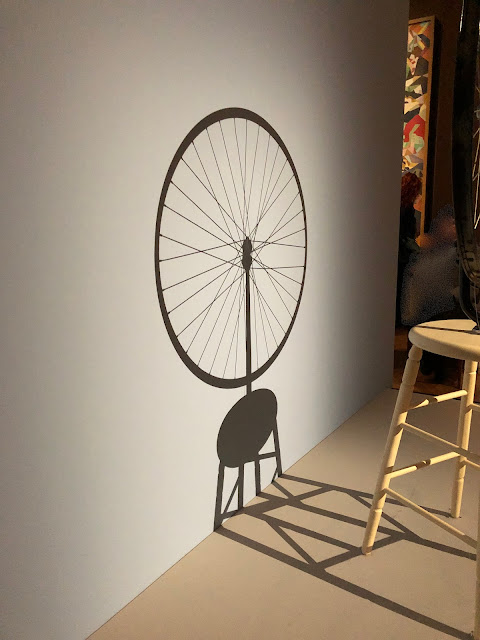 |
| "Roue de bicyclette," Marcel Duchamp (originally, 1913, later 1951) |
Marcel Duchamp was not the original bullshit artist, nor even the most audacious. But he may be best remembered now for what amounted to pranks on the art establishment, notoriously submitting a urinal to an art exhibition (signed "R. Mutt") and titling a snow shovel "In Advance of the Broken Arm." "Bicycle Wheel" is much a much subtler piece of kinetic sculpture, but still seems intended to provoke less-disciplined thinkers into pointless arguments about "what is art?" and perhaps into more important considerations about who gets to decide (the answer is people with money, in case you have other things to do besides read the rest of this).
If the information card on this display at the Petit-Palais as part of the "Le Paris de la Modernité, 1905-1925" exhibit is correct, Duchamp was greatly inspired by a visit to one of the early Paris aviation shows. "Painting is dead" he is said to have remarked after considering the graceful curves of a carved and lacquered propeller. Whether or not he actually wrote or uttered this statement (more likely, something to the effect of "peindre, c'est mort"), his enthusiasm for some homely thing that is both useful and pleasing to the eye suits my tastes well. At museums or anywhere else, I'm always more taken with practical, utilitarian items and with illustrations well-executed for a distinct purpose than with more nebulous works from which we are supposed to extract some big idea (our own, or the artist's). At la Modernité, cubism left me cold (as ever), but I really enjoyed the fashion and jewelry, and especially the vintage vehicles and aeroplanes on display (as ever).
 |
| Elegant, well-crafted, and functional. No wonder Duchamp swooned. |
I also got a great kick out of the costumes used in Vaslav Nijinsky's monumental 1913 staging of Stravinsky's "Rite of Spring" at the Théâtre des Champs Élysées. There is just something about a ballet causing mayhem among furious audience members ("a near riot" according to some sources) and decades of scorn by critics that tickles me. What Duchamp sought to instigate by being a wiseguy, Nijinsky, Stravinsky, and their ballet company achieved through integrity and earnestness. If that ain't art, there is no such thing.
 |
| A costume "for a young girl," Rite of Spring (1913). Clearly not a werewolf, but ballet-goers acted like beasts and that's good enough for me. |






Comments
Post a Comment